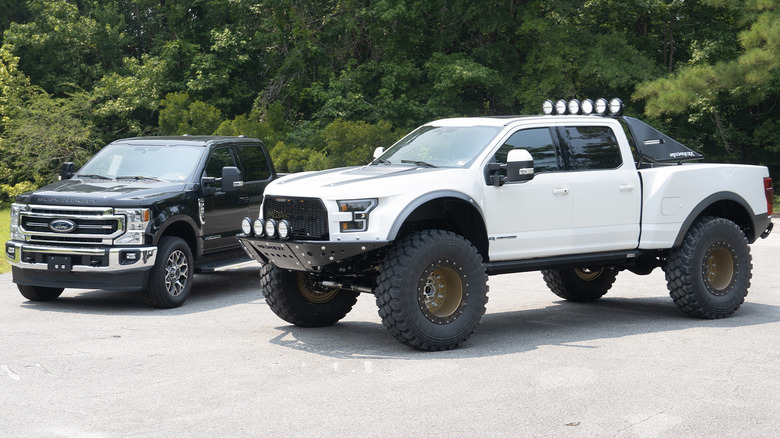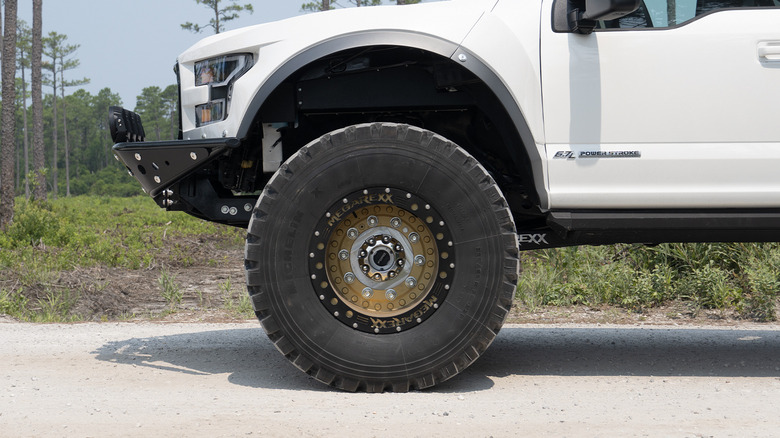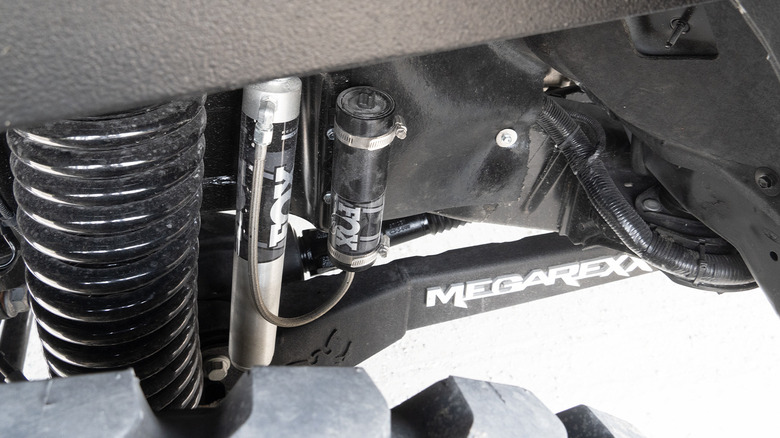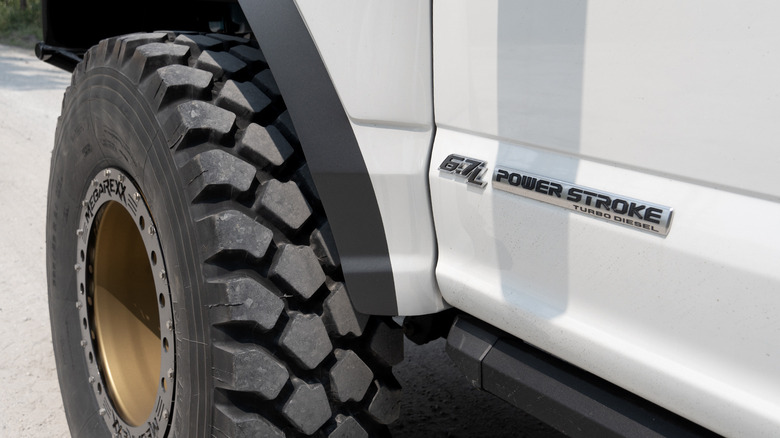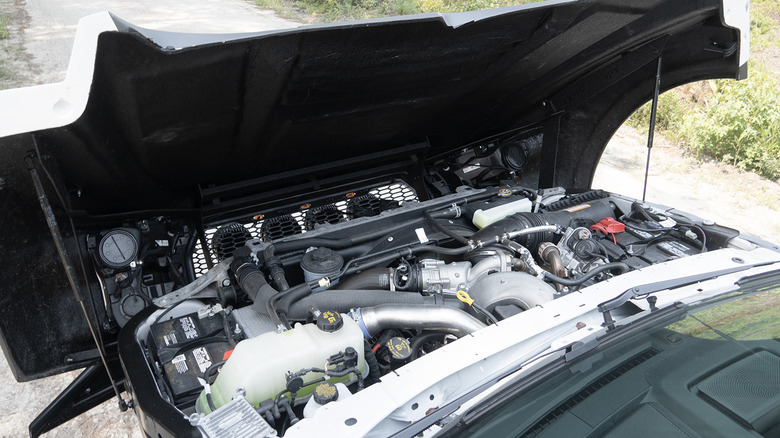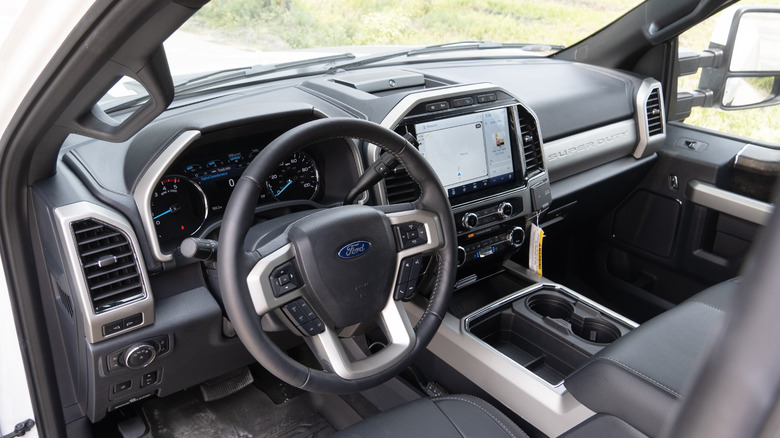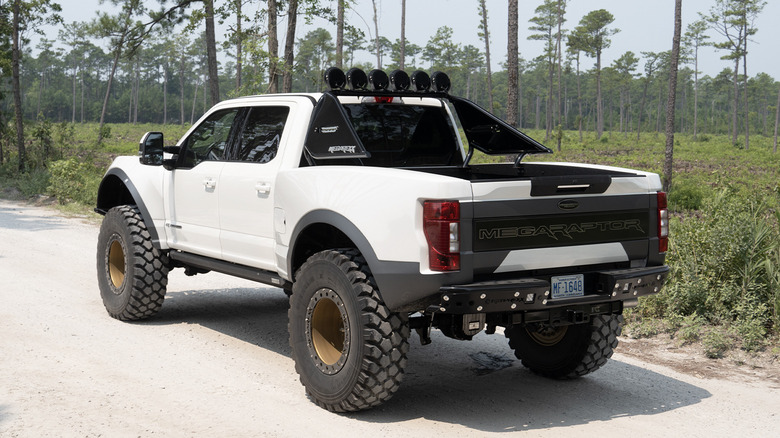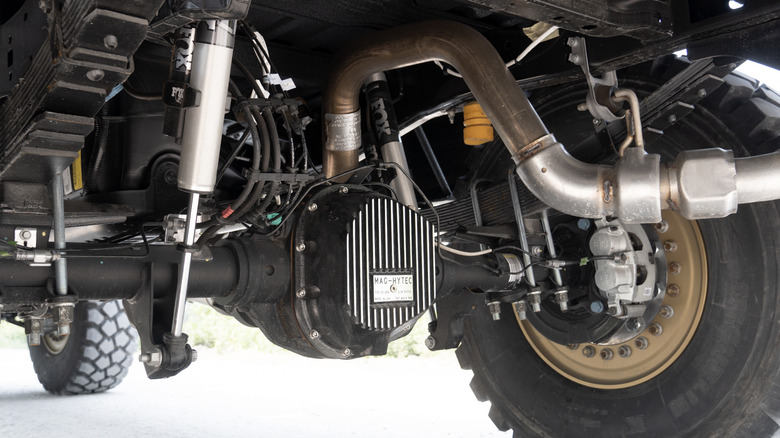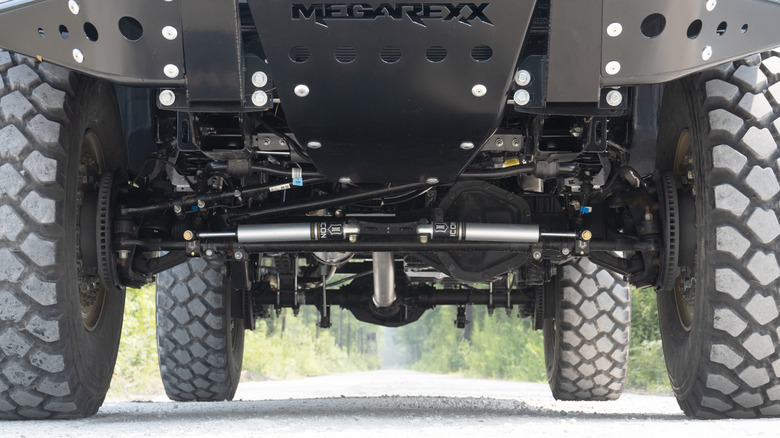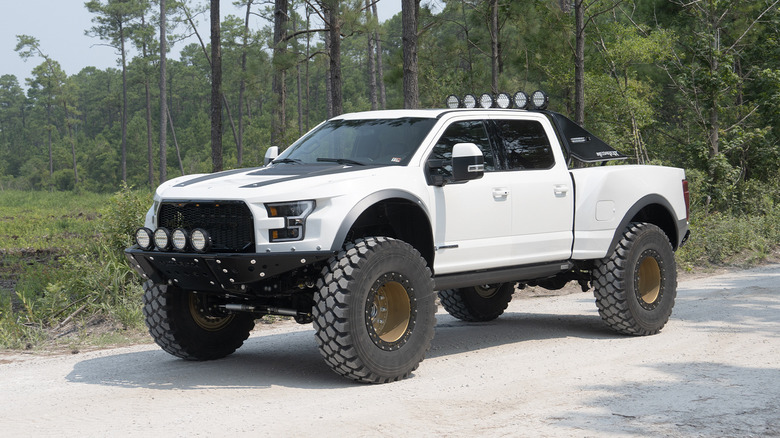MegaRexx MegaRaptor Review: Could You Daily Drive This Street-Legal Monster Truck?
- Is it a monster truck or a trophy truck?
- Surprisingly easy daily driver
- Ford powertrain warranty still applies
- Reasonable pricing in today's aftermarket industry
- Undeniable excess in pickup truck form
- Turns heads and not always in a good way
- Just imagine getting a flat tire
Not many vehicles give a good viewing angle of a Ford F-150 Raptor's rooftop. And yet, driving around the swamps of North Carolina in a MegaRexx MegaRaptor, I looked down at the tops of Raptors, Ram duallies, TRXs, and even F-550 work trucks alike. That's because the MegaRexx starts with an F-250 Super Duty and then transforms the production pickup truck into the closest thing to a trophy or monster truck still legal to drive on public roads.
Despite the MegaRaptor absolutely dwarfing just about anything else on the road, MegaRexx owner and CEO Aaron Richardet claims that customers can still enjoy the Ford factory powertrain warranty—a major plus for anyone willing to drop around $150,000 on such an insane rig. Other than the financial commitment to undeniable excess, though, I flew into North Carolina very curious to experience how a MegaRaptor handles getting down and dirty, not to mention how inconvenient such a massive truck might be to daily drive.
Acclimating to a new driving elevation
A MegaRaptor requires serious mental readjustment to the simple details of driving. Just climbing up into the driver's seat, the electronically retracting running boards made life much easier despite my 6'1" frame with long legs. The sheer size of 46.7-inch tires—yes, we've come a long way beyond 35s or even 40s—puts the top of the rubber almost up to my chest. Once in the captain's chair, pulling out into traffic I almost immediately noticed that I sat at nearly the same height as semi-truck drivers. Anyone who suffers from vertigo might want to look elsewhere, to say the least.
The gargantuan Michelin X tires, billed as "Military" tires on Michelin's website with a load range J indicating 18-ply construction, undoubtedly serve as the highlight of the entire MegaRaptor project and essentially force the rest of the build into place. Custom 20-inch wheels are mandatory, while fender flares extend the Ford body panels just about as wide as a standard truck with duallies. The one-piece clamshell hood actually folds forward, in almost British sports car fashion, above an aggressive steel front bumper. A matching rear unit, plus a half rack in the bed wraps up the look, at least from a more typical exterior perspective.
Suspension revisions to support those tires
Because of the ride height created by those tires, however, MegaRexx's suspension revisions come into focus, as well. The overall styling actually creates something of an optical illusion—surely an eight-inch lift must be required to clear the tires, but in fact, only 4.5 inches of lift allow for enough space beneath the body to cram in aftermarket components from Icon Vehicle Dynamics, Fox, Carli, and BDS. MegaRexx also installs new control and trailing arms, flexes up the leaf springs, and adds steering stabilizers to help with driving dynamics given the overall height and heft of the truck.
The truck itself, meanwhile, started life as a Ford F-250 Super Duty in Lariat trim, because Richardet knows his customers (and me, on a hot Southern day) want their ventilated seats, Apple CarPlay, and remote start. Unlike the "normal" F-150 and Bronco Raptor variants, starting with an F-250 means that the MegaReptor uses a solid front axle, a critical detail for driving dynamics but also durability given all of MegaRexx's modifications.
Power and poise in a purposeful build
As much as the (formerly) stock truck, aesthetic revisions, and aftermarket components might create an aura of trophy-monster truck, tires are always the first and most crucial part of an overall suspension system. Each of the MegaRexx's four wheel and tire combos together weighs an absurd 425 pounds. At 15.5 inches wide with tread design even more aggressive than most mud-terrains, the Michelins absorb much of the harshness that a lift on more typical tires might produce.
A tradeoff becomes noticeable at both low and high speeds, though, when tread hum transitions to a bit of chatter rolling to and from a stop. The MegaRaptor gets up to highway speeds with ease but from an auditory perspective in the driver's seat, seems happiest in the 30-45 mile per hour range. The F-250's 6.7-liter Power Stroke turbodiesel pushes 40 PSI of boost, and for 2023 puts down an absurd 1,050 lb-ft of torque in stock form. Combating the mechanical disadvantage of nearly 14 additional inches of tire diameter—up from 32.5 inches stock—MegaRexx throws on a Pedal Commander to increase throttle sensitivity.
Regearing to support the Power Stroke turbodiesel
Richardet also regears the front and rear axles with OEM Yukon 4.88 ratios, versus the original 3.31 final drive, and the resulting wheel torque truly borders on peppy. A High Output Power Stroke might up the output even further to 1,200 lb-ft but at the very least, nobody can call a MegaRaptor sluggish, something that many trucks with significantly larger tires tend to suffer from under load.
Driving instructors typically advise new drivers to imagine an egg between their foot and the throttle pedal. Of course, behind the wheel of a MegaRaptor, the impulse to floor it always overcomes any saner inclinations—the spirit of such an absurd truck forever shines through—but easing into the gas during the course of stop-and-go traffic or on longer backroads brings the beast up to average speeds without fuss. Then, stomping hard can almost chirp the tires, though due to the Pedal Commander, full throttle actually arrives a little earlier than the pedal actually hits the metal at the end of its travel.
An approachable monster truck
If the power delivery feels sufficiently factory original, the actual act of driving a MegaRaptor takes a warmup period. Mostly, I spent conscious energy trying to figure where in the world my passenger side front tire actually touched the ground. Height and width paired with huge fender flares create a challenge, compounded by the fact that the power delivery and steering quality almost create the perception of normal driving. This quandary can be solved only with more seat time.
Throughout any time in traffic, wide towing mirrors with a small downward-tilted frame for keeping an eye on my large blind spots helped a ton, especially since a lowslung sports car could probably sneak by without showing up in my field of vision at all, riding entirely beneath the level of my feet working the pedals. At highway speeds, the wide tires never tramlined on rougher roads and other than the hum of tread or wind whistling through the light pods on the MegaRexx half rack, I might well have just been in a bone-stock F-250.
In tighter quarters, I started the day pulling extra wide around turns, expecting the rear tires to track through tighter arcs as a trailer might. But then I realized that the MegaRaptor adds nothing to the overall wheelbase, just a bit of width. By the end of my day with the MegaRaptor, the adjustment period felt ample and I even parallel parked for a late lunch without too much trouble. Parking head-in, on the other hand, requires waiting for an extremely wide spot to open up.
The optical illusion of a MegaRaptor
Simply capturing the true size of a MegaRaptor in photos presents a challenge, as I discovered during a quick break from blasting down a remote dirt road. Clamboring out (again, very much appreciating swingout running boards), spindly trees provided little in the way of context for appreciating how high an F-250 with a 4.5-inch lift actually sits over 46-inch tires. Luckily, Richardet let me pose my truck next to a stock F-250 destined to receive the MegaRexx treatment next as a way of providing a bit more proportional context.
On the dirt road, the Michelins and suspension found time to shine, gobbling up washboards and minor whoops without transferring much in the way of shocks or jounces into the F-250's passenger compartment. I never worried about finding mud in the swamp, but presumably the ride quality would only get better if I took the time to air down. While parked, at the very least I took the opportunity to crawl around and inspect the beefy underbody, with remote reservoir dampers front and rear, custom exhaust, and enormous differential pumpkins in plain sight.
Later, I asked Richardet about that warranty coverage from Ford, especially curious about the axle durability given the enormous strain created by the 46-inch tire diameter. But apparently, MegaRexx's trucks never suffer from stripped splines—a testament that Ford still builds Fords tough, at least in the Super Duty class. The solid axles undoubtedly make the entire MegaRaptor concept possible, since CV joints on independent front suspension trucks like the F-150 and Bronco Raptors would probably shred to bits the first day driving out of Richardet's shop.
What kind of customer buys a MegaRaptor?
The showstopping size of a MegaRaptor attracts exactly the kind of attention that Richardet intends. He bought MegaRexx as a company out of Arizona after seeing a truck during the Scottsdale auctions one year—since then, he's heard every joke at gas stations and every snide comment. MegaRexx customers want that head-turning presence, especially blue-collar business owners who essentially purchase a MegaRaptor as a form of rolling advertisement.
And demand is no joke. The MegaRexx shop always has another project underway, and lead times currently hover between four and six weeks after a customer puts down a deposit on a build. The entire package runs about $60,000 depending on specifics—a big brake kit, which I would have appreciated, can add almost $10,000 on top. For context, a base F-250 Lariat runs about $82-83,000 currently, so tacking on another $60,000-plus runs up to and past $150,000 pretty quickly.
A screaming deal amid today's exploding restomod industry
But in today's restomod and custom car industry, a price tag of $150,000 can easily seem negligible. I drove an $800,000 Bronco not too long after the MegaRexx, and custom carbon-bodied creations regularly run into the seven figures. Richardet knows that MegaRaptor buyers probably don't overlap in the Venn diagram with Singer Porsche owners, but his two other ventures building Land Rover Defender and Dodge Power Wagon restomods sure do.
Only later, I realize a major difference between climbing (literally) behind the wheel of a MegaRaptor and most custom or classic cars: Richardet never needed to give me a huge spiel about what buttons to push, what gauges to keep an eye on, or when to drive hard. Instead, I just flipped on those ventilated seats, cranked some tunes via CarPlay, and pulled up Waze to warn me about cops (who I figured must know about MegaRexx given the undeniable bearing of the trucks as they cruise around through traffic).
Dreaming of real off-roading in a MegaRaptor
Very few, if any, MegaRexx customers ever take their trucks into any serious off-roading scenarios, a fact that Richardet knows well. But he believes in the build quality enough that I never received a warning to not hit any dirt. I did wish for some time with the truck in the dunes of Southwestern United States, rather than graded tracks in the swamps where turning into a narrower unknown trail might result in a pinch for something so wide.
Dune-charging at Glamis or Baja seems more appropriate, without a doubt, but Richardet also has an enormous enclosed-cabin MegaRaptor project underway that will seat 10 and serve as a tour truck in Iceland, so both the Ford factory and MegaRexx engineering will soon undergo a serious test of toughness in the near future. There, the 15.5-inch wide tires and ground clearance will help tourists reach some of the most remote areas on the planet, without concern for high-centering on boulders or getting stuck in snow along the way.
Rolling back to the shop, one hand on the wheel nonchalantly, I looked out over my surroundings from on high one last time. Next I planned to drive a Defender built by MegaRexx's sister company, Osprey Custom Cars, but after a full day in a MegaRaptor, the prospect of driving a normal-sized vehicle seemed like a bit of a letdown. Maybe we should have planned my drives the other way around, it turns out, since the biggest surprise about actually driving a MegaRaptor was just how quickly I acclimated to life with such a behemoth.
